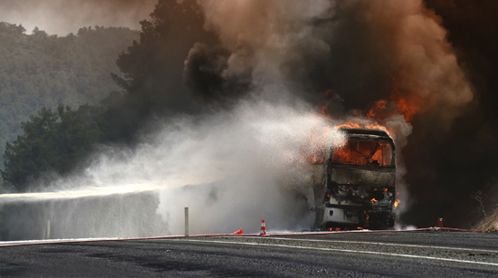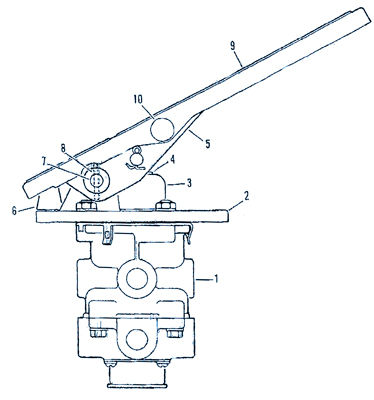
How preventive maintenance can stave off disaster
By Glenn Swain
Earlier this year the Commercial Vehicle Safety Alliance considered issuing an emergency inspection bulletin throughout North America for all motorcoach operators targeting a problematic brake treadle valve that could be causing an unknown number of bus fires and catastrophic brake failures nationwide. A series of incidents of bus fires and what is called brake fade, where brakes and brake drums become white hot and fail to work, had been occurring more and more. An investigation continues into the brake treadle valve, and so far no inspection bulletin has been issued.
In February, BUSRide Maintenance magazine first reported possible concerns about bus brake treadle valves.
An increasing number of bus mechanics and tow operators are seeing more fires beginning in the wheel areas of buses and other cases of hot brakes. The problem could lie in the treadle value. Here is a common scenario. As a bus operator climbs in and out of the vehicle, they naturally track in dirt, road salt and grime. That debris eventually works its way down along the brake pedal, the floor mat, then into the pivot pin that allows the brake pedal to move downward. The metal brake assembly is mounted to the treadle valve. The pin for the pedal is steel, but the housing for the treadle valve is aluminum. Two dissimilar metals are now beginning to react together, which causes corrosion. Over time, the corrosion expands just like rust. That begins to pinch the pin, where eventually it stops pivoting as it was made to do.
At this point when the brake pedal is released, the brake shoes relax and pull away from the brake drums and air pressure returns the pedal back into position. But if a bus has pivot pin that’s bound up, the brake pedal will not completely return. This allows the pedal to keep perhaps up to ten pounds of pressure, allowing the brake shoes to remain against the drums because they are not releasing fully. There’s not enough air pressure being exerted that would alert a driver to feel the drag. But as the bus speeds down a freeway enormous energy builds. This could eventually go beyond what is called “brake fade,” an occurrence where brakes become so hot drivers lose the ability to stop the vehicle. It’s also commonly referred to as a brake “white out,” where the brakes get so hot they turn fiery white. Continued friction can result in the driver having no brakes and causing serious accidents or damaging fires in wheel areas that can end up rendering the bus a complete loss.
Highway fires
On May 28 around 12:30 a.m., the driver of a 2006 MCI 4500 pulled into a service plaza off the MassPike at Charlton. The bus began rolling backward down an incline after the driver set the parking brake. Unable to brake stop the bus, the driver jumped out, leaving the vehicle to roll more than 60 feet into two cars being fueled. The motorcoach rolled over two gas pumps before a foot-high curb brought it to a stop. A woman and two small children were in one of the vehicles. There were no passengers on the bus at the time, no one was injured in the vehicles, and no fire occurred.

“The bus just went down through there like a bowling ball and kept knocking these cars around like pins,” said Craig Moran, the owner of Sturbridge Service Center in Sturbridge, MA, who later examined the motorcoach. “If he had gone another eight miles and gotten off at Interchange 9 at Sturbridge, he would have come up to the toll plaza. If he had stepped on the brakes, and the lanes were full of cars, somebody would have gotten whacked.”
Moran added that he later found the bus’s treadle valve hung up with 10 to 15 pounds of pressure on the brake chambers.
Moran recalls being called out to the Massachusetts Turnpike to haul in a 1998 Van Hool T-2145 that was on fire. When Moran arrived on the scene all passengers had been evacuated and flames were shooting out through the roof.
“The fire began in the duel wheels,” Moran says. “It took out the windows, aluminum siding and was burning up the seats and through the escape hatch. The rest of the bus had heavy smoke damage. All the passenger bags were contaminated.”
After the fire was extinguished Moran hauled the Van Hool back to his shop. While still on the wrecker, he got inside and pushed the brake pedal down and let go. Moran says he took his finger and pulled the pedal up a short distance to the beginning position and heard the familiar “chuuuu” sound of the air brakes. Eventually, the bus was sent back to the ABC Companies Service Center in Faribault, MN and used as salvage.
Days later Moran received a call about hot brakes on a MCI motorcoach, which he towed to a dealership. Later that week, Moran rescued yet another bus in Connecticut after the right front wheel on a bus burst into flames. As he was towing it in the right rear tag wheel caught fire. He quickly ascertained that nothing wrong had occurred in the towing process and the bus’s brakes had been released properly. Moran theorized it was a seized pin that had caused the fire.
Moran says a simple application of lubricating oil during a vehicle’s normal oil change schedule could greatly reduce the number of fires that he sees occurring for operators. Another idea is to routinely replace the treadle valve as needed. BR
